Layered metastructure containing freely-designed local resonators for wave attenuation
Yu Li ,Hugung He , Jing Feng , Hilong Chen , Fengnin Jin , Hulin Fn c,d,e,*
a State Key Laboratory for Disaster Prevention & Mitigation of Explosion & Impact, Army Engineering University of PLA, Nanjing 210007, China
b Rocket Force University of Engineering, Xi'an 710025, China
c Henan International Joint Laboratory of Dynamics of Impact and Disaster of Engineering Structures,Department of Civil Engineering,Nanyang Institute of Technology, Nanyang 473004, China
d Guangxi Key Laboratory of Disaster Prevention and Engineering Safety, and Key Laboratory of Disaster Prevention and Structural Safety of Ministry of Education, College of Civil Engineering and Architecture, Guangxi University, Nanning 530004, China
e Research Center of Lightweight Structures and Intelligent Manufacturing, State Key Laboratory of Mechanics and Control of Mechanical Structures,Nanjing University of Aeronautics and Astronautics, Nanjing 210016, China
Keywords:Layered metastructure Local resonator Wave attenuation
ABSTRACT Combining periodic layered structure with three-dimensional cylindrical local resonators, a hybrid metastructure with improved wave isolation ability was designed and investigated through theoretical and numerical approaches.The metastructure is composed of periodic rubber layers and concrete layers embedded with three-dimensional resonators, which can be freely designed with multi local resonant frequencies to attenuate vibrations at required frequencies and widen the attenuation bandgap.The metastructure can also effectively attenuate seismic responses.Compared with layered rubber-based structures, the metastructure has more excellent wave attenuation effects with greater attenuation and wider bandgap.
1.Introduction
Vibration isolation is important for building structures and here are various damping devices to reduce the input energy before the energy is transmitted to the building.Now metamaterial has been introduced into seismic-resistant engineering to further attenuate seismic wave energy [1,2].Cloaking, local resonance and layered structure are three typical mechanisms of metamaterials.Seismic invisibility may be fulfilled by seismic cloaking via symmetrized transformation media.But this measurement is far from engineering.
An et al.[3] studied vibration attenuation effect of meta-lattice structures through local resonance mechanism.Mitchell et al.[4],Briccola et al.[5]and Liu et al.[6]proposed a kind of meta-concrete based on local resonance resonators, formed by mass blocks encased by soft coatings.The spring-mass like resonator will resist wave propagation through resonance when the wave frequency is close the resonance frequency of the resonator.Xu et al.[7] systematically studied the key factors affecting the band gap.Bursi et al.[8] developed two finite locally resonant multiple degrees of freedom metastructure, and derived the dispersion relationship.
By adding soft media such as rubber to dissipate energy and reduce vibration,Cheng et al.[9]studied wave attenuation effect of periodic layered structures made up of rubber layers and concrete layers.Cheng and Shi [10,11] designed a periodic structure composed of two-dimensional reinforced concrete slabs and rubber layers and found that the reinforcement has little influence on the attenuation.These layered structures can attenuate waves by Bragg scattering and local resonance mechanisms and can be used to construct seismic isolation foundation [12,13].
Zeng et al.[14] demonstrated the feasibility of using periodic structures as a seismic wave barrier.Miniaci et al.[15] focused on the frequency range of seismic waves and explored the configuration of metamaterials.Zeighami et al.[16] designed a resonant wave barrier with resonators of different frequencies to achieve broadband wave attenuation.Periodic barrier can block incoming waves within the frequency band gaps by burying around the protected area and thus mitigate damages of seismic activities.A series of field tests are conducted to assess the combined usage of period barrier and periodic foundation in a manner to achieve better wave isolation effect [17-19].
In this paper, based on layered vibration isolation and threedimensional resonator, a metastructure was proposed.The mechanism of wave attenuation of layered and three-dimensional composite foundation was studied.
2.Metastructure and mathematical modeling
2.1.Metastructure
The metastructure is composed of periodic concrete layers embedded with three-dimensional resonators and rubber layers,as shown in Figs.1(a) and 1(b).The resonator is made up of soft rubber-encased metallic cylinder.
A simplified model for the metastructure is displayed in Figs.1(c)to 1(f).Each concrete layer is simplified as an outer frame.And the rubber between the concrete layers is simplified as a spring with stiffness of K1, K2or K3.Inside each outer frame, there is a resonator with spring stiffness of k1/2, k2/2 or k3/2.M1and M2represent outer frames’ masses.m1, m2and m3denote the weight of the mass block.u21, u22and u23are the displacement of the mass block.The displacement of the outer frame is denoted by u11,u12and u13, respectively.In this research, the parameters of each layer are the same, where K1=K2=K3=K , k1=k2=k3=k ,M1=M2=M3=M , and m1= m2= m3= m.f(t) is the force.R and r represent the radius of the resonator and the mass block,respectively.H and h denote the height of the resonator and the mass block, respectively.tvand threpresent the thickness of the silicon rubber layer out of the mass block in the vertical and horizontal directions, respectively.SL1 and SL2 represent periodic foundation without and with resonators, respectively.Material parameters are listed in Table 1.
The natural frequency of the resonator along direction X is calculated by
with Refs.[20-22].
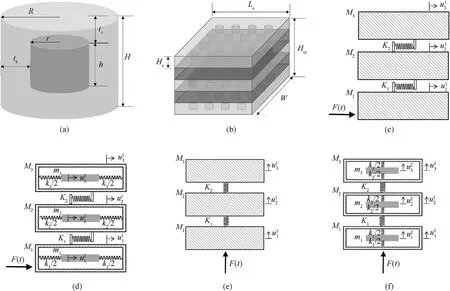
Fig.1.Constructions of (a) resonator with metallic cylinder encased by silicon rubbers and (b) metastructure with periodic rubber layers and concrete layers embedded with periodic resonators.Simplified model of finite periodic foundations when vibrating (c) SL1 horizontally, (d) SL2 horizontally, (e) SL1 vertically, and (f) SL2 vertically.

Table 1 Material properties.
where A is the simplification of the contact area when the mass block vibrates horizontally.E (MPa) is the elastic modulus of the soft silicone converting from the Shore hardness s and G is the shear modulus.With R = 0.035 m, t = 0.0354 m, h = 0.04 m, s= 200and material propertied in Table 1, k = 227395.7 N/m, E =0.3144 MPa, G=0.2927 MPa and A = 0.0028 m2.Then the frequency is given by ωr=150.8 rad/s and f = ωr/(2π) = 24 Hz.According to the calculation,the horizontal fundamental frequency of the resonator is 24 Hz.Similarly,when the calculation of vertical natural frequency is simplified, the resonator vibrates vertically.The upper and lower silicon rubber layers are simplified as springs with stiffness of k/2.
Here, k=9869.6044 N/m, ωr=31.42 rad/s and f = 5 Hz.The fundamental frequency in the vertical direction is 5 Hz.
2.2.Motion equations of metastructure
The metastructure model with dimension of 1 m×1 m×1 m is shown in Fig.1(b).The thickness of each layer is 0.2 m.The resonators in each concrete slab were arranged in the form of 4×4.The simplified model is shown in Figs.1(c)to 1(f).The finite period end is free,and a simple harmonic force is loaded on the left end or the bottom end,as shown in Fig.2.The dynamic equilibrium equations of the finite periodic structure system are given by
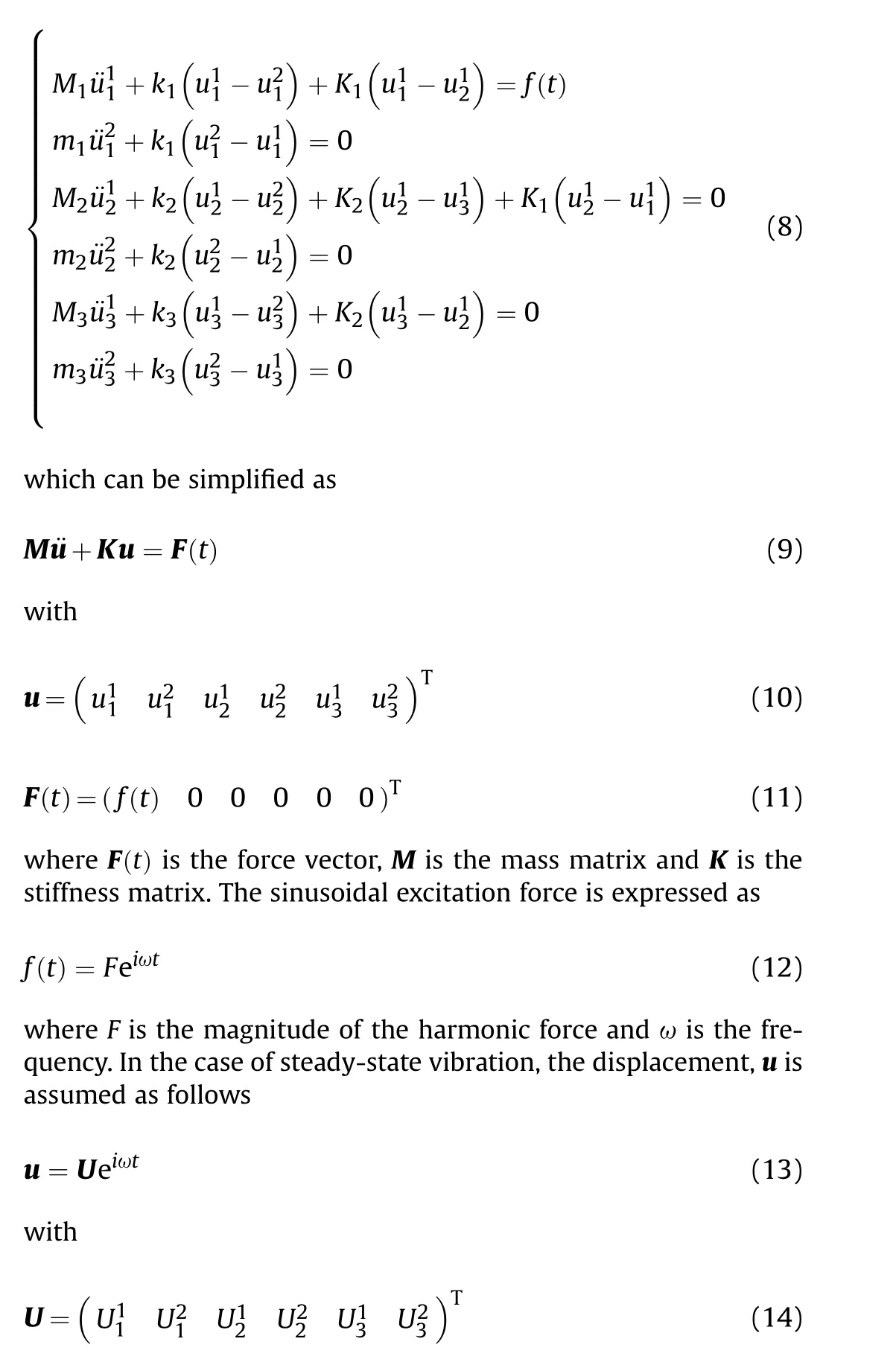
where U represents the magnitude vector.Substituting Eqs.Eqs.(12) and (14) into Eq.(9),

Fig.2.Theoretical bandgap of resonator with resonance frequency of (a) 24 Hz in horizontal vibration and (b) 5 Hz in vertical vibration.
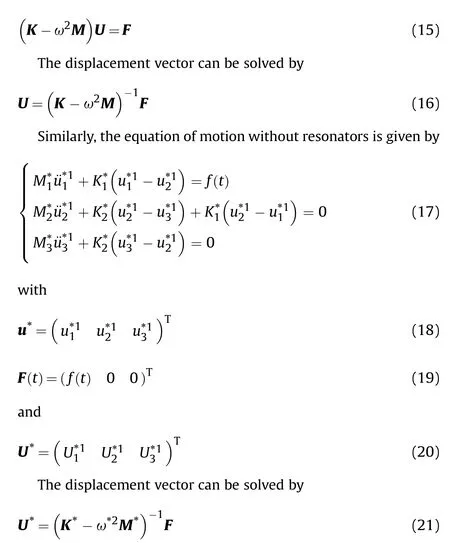
Here,symbols with"*"represent variables of structure without resonators.
2.3.Bandgap analyses
According to the equivalent negative mass method [23], the effective mass of a layer, meff, is obtained as

where θ=m/M is the ratio of internal mass m to the outer mass M,ωr=2πf is the local resonance frequency of the internal resonator mass, and mst=M+m is the static mass of the microstructure.Plots of meff/mstwith respect to ω are presented in Fig.2.It is clear that adding resonators with designed frequency to the metastructure indeed forms an attenuation bandgap(AD) in the design frequency range.
3.Numerical investigation
The numerical model of the metastructure is shown in Figs.3(a)and 3(b).SL1 and SL2 represent foundation without and with resonators, respectively.The model adopts implicit analysis method.The switch of implicit analysis is turned on by keyword "CONTROL_IMPLICIT_GENERAL", and the time step is controlled by keyword "CONTROL_IMPLICIT_AUTO".This keyword computes frequency response functions due to nodal excitation.At the bottom, an instantaneous unit displacement with an excitation frequency of 0-100 Hz is applied along direction X, and there is no constraint in direction X.At the bottom, an instantaneous unit displacement with an excitation frequency of 0-100 Hz is applied along direction Y, and there is no constraint in direction Y.The excitation direction is displayed in Figs.3(a)and 3(b).
According to Eq.(16),the displacement of the output end can be calculated as u13.The frequency response function (FRF) is defined by

Fig.3.Excitation from (a) direction-X and (b) direction-Y.FRF companions between theory and numerical simulation of foundation SL1 along (c) horizontal and (d) vertical directions.FRF companions between theory and numerical simulation of foundation SL2 along (c) horizontal and (d) vertical directions.
where u11and u13are the displacement amplitudes at the input and output ends,respectively.According to Eq.(24),the FRF curve of the metastructure under a simple harmonic load can be calculated or simulated, as shown in Figs.3(c) to 3(f).Through theory and simulation, it can be found that SL1 also attenuates because the rubber layer reduces vibration and absorbs energy.The theoretical value is slightly larger than the simulated value,which is caused by the error in the calculation of rubber elastic modulus.
The designed horizontal frequency of the resonator is 24 Hz,and the vertical is 5 Hz.From Figs.3(e) and 3(f), the theoretical and simulated attenuation regions conform to the design frequency interval with apparent attenuation.The FRF near the attenuation region also increases, which is the peak value generated by frequency resonance.
4.Vibration attenuation for steel frame built on metastructure
4.1.Modeling
Establish a steel frame on the metastructure to check the vibration isolation effect of the metastructure to the upper structure,as shown in Figs.4(a)and 4(b).All the steel frames are constructed by rectangular beams and columns, and the floor slabs are reinforced truss floor decks.Eq.(24)defines the FRF.The cross-section of the beams is 0.03 m×0.06 m, and for the columns it is 0.03 m×0.06 m.The thickness of each slabs is 0.003 m.
The bandgap characteristics of the structure are characterized in Figs.4(c) and 4(d), through comparing the spectrum diagrams of foundations with and without resonators.The attenuation effect is excellent over 30 Hz when the structure is horizontally excited.Below 25 Hz,the attenuation effect is not ideal.Only around 19 Hz,the attenuation is excellent.The resonance frequency of the metastructure is 24 Hz.The resonator can attenuate a strong vibration at 24 Hz for foundation SL1 and forms a wave attenuation band,90%attenuation at the apex, as shown in Fig.4(c).When the system is excited vertically,foundation SL1 will produce a string vibration at 4 Hz.As the vertical resonance frequency of the metastructure is 4 Hz, this apex can be attenuated, and a band is formed, 74%attenuation at the apex, as shown in Fig.4(d).However, the attenuation effect is weakened between 3 Hz and 7 Hz.
4.2.Bandgap
Adding three-dimensional resonators can effectively attenuate vibration around the resonance frequency.Engineers can preset resonators with specific frequency according to the attenuation requirement.In Fig.5, the horizontal FRF curve of SL1 without resonators has two peaks below 10 Hz and two peaks over 15 Hz,and the vertical FRF curve has three peak points.The resonance frequency of SL2 can be set as 17 Hz and 24 Hz to attenuate the horizontal peak points, respectively, as shown in Fig.5(a).The resonance frequency of SL2 can be set as 18 Hz and 24 Hz to attenuate the vertical peak points, respectively, as shown in Fig.5(b).

Fig.4.Two steel frames built on (a) foundation SL1 without resonators and (b) foundation SL2 with resonators.Bandgap of steel frame built on foundation SL2 with resonance frequency of (c) horizontal 24 Hz and (d) vertical 4 Hz compared with that on foundation SL1.
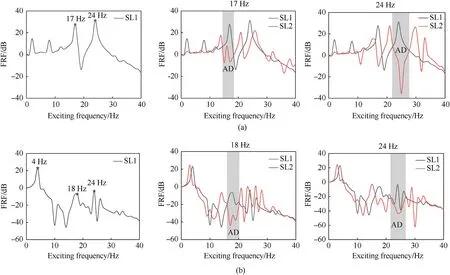
Fig.5.Wave attenuation through embedding resonators with specific frequencies for (a) horizontal and (b) vertical excitation.
The attenuation effect is evident in the designed frequency.The peaks are attenuated,and a bandgap is formed around the designed frequency.Nevertheless, the other peaks still exist.Design the multi-resonators set in the metastructure to eliminate more peak points.The attenuation region can be designed for a particular frequency band.As shown in Fig.6,two or three types of resonators are introduced in the metastructure.There are two ways to preset the resonators.One is that each layer has the same resonators(B1).The other is that each layer has multi-resonators (B2).The peaks can be significantly attenuated according to the preset resonance frequencies and appear two or three bandgaps.As the local resonance mechanism is frequency dependent, the attenuation effect cannot be completely guaranteed over the designed frequency.
In the B1 layout,the width of the bandgap is much greater,and the attenuation effect is also higher.According to Figs.7(a)to 7(d),it can be concluded that by presetting two types of resonators for two peaks, both peak points can be removed simultaneously, and the isolation effect is excellent.From Figs.7(e) and 7(f) presetting three types of resonators for three peaks in three concrete layers can reduce the peak value and form three frequency bands simultaneously.In the B2 layout,the width of the attenuation band is much smaller.
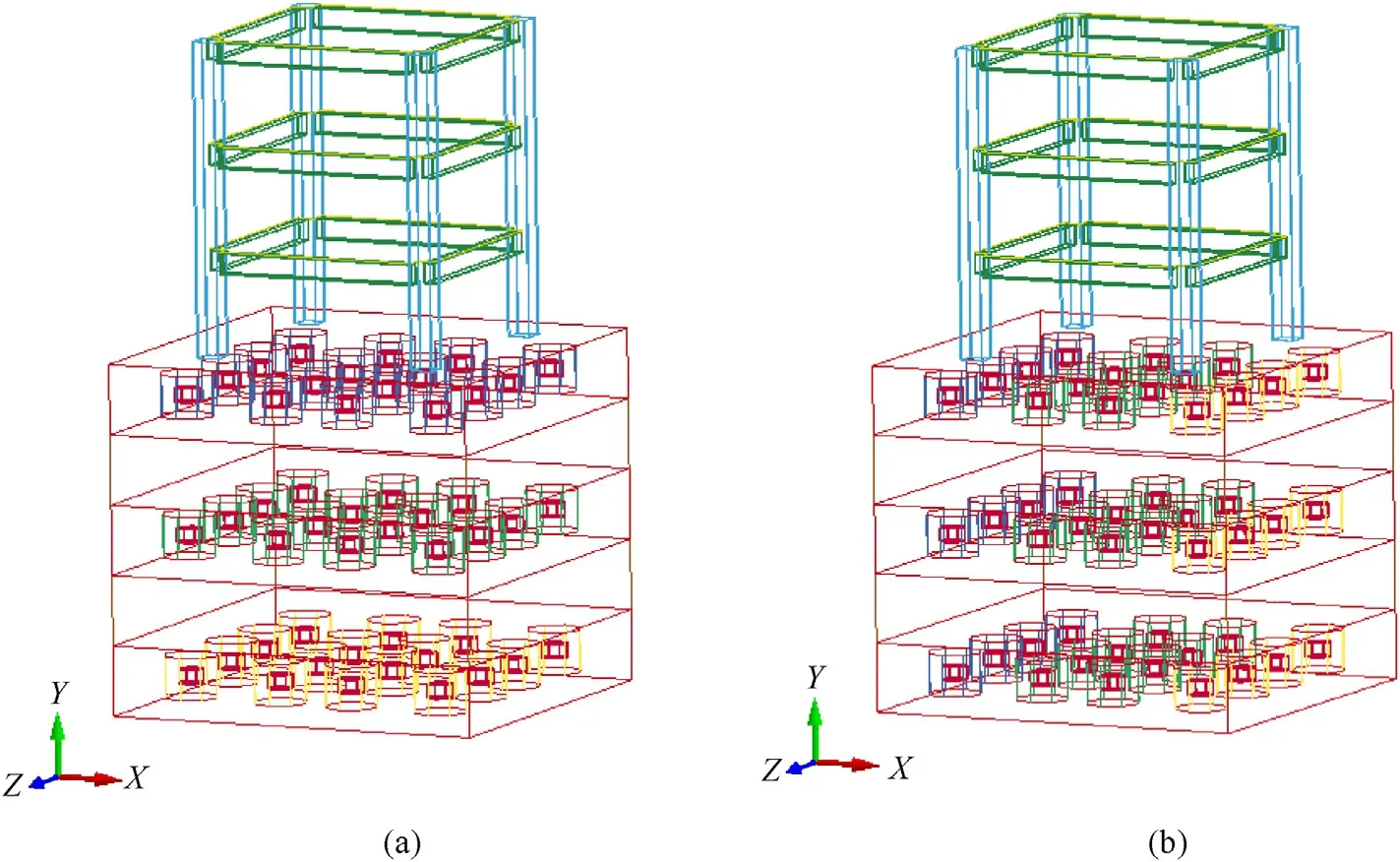
Fig.6.Schematic diagram of multi-resonator layout: (a) Each layer has the same resonators (B1); (b) Each layer has multi-resonators (B2); Resonators with different colors represent different resonant frequency.

Fig.7.FRF curves and bandgap of metastructure with multi-resonance frequencies: Two types of resonators present in (a) B1 layout, (b) B2 layout with horizontal frequencies of 24 Hz and 17 Hz,two types of resonators present in(c)B1 layout and(d)B2 layout with vertical frequencies of 24 Hz and 4 Hz,and three types of resonators preset in(e)B1 layout and (f) B2 layout with vertical frequencies of 24 Hz,18 Hz and 4 Hz.
Therefore,if the FRF curve of a building or structure is given,the vibration attenuation can be fulfilled through reasonably presetting resonator frequencies.
It must be pointed out that the design can achieve vibration attenuation in the designed frequency band for special requirements.However, the frequency response in other frequency ranges can be increased.
5.Seismic wave attenuation
5.1.Seismic wave
To verify the vibration attenuation of the metastructure, the seismic acceleration time history curve of the 1975 Oroville earthquake[24]was applied on the structure,as shown in Fig.8(a).Fig.8(b) shows the frequency-domain expression of the OROVILLE seismic wave, and the main frequency is 18.1 Hz.The designed frequency is 20 Hz.
The system damping is 1.1 rad/s, and the damping ratio is 5%.Fig.8(c)displays the horizontal acceleration response.The transfer function is defined by the ratio of the output acceleration and the input acceleration in the frequency domain, as shown in Fig.8(d).The transfer function ratio is the ratio of the transfer functions of the two systems, as shown in Fig.8(e).
It is evident from Fig.8(c)that when targeted 20 Hz resonators are embedded in the foundation, the acceleration of the overall structure in the seismic can be significantly reduced from 0.15 to 0.08 g.The acceleration response of SL2 is significantly smaller than that of SL1, with maximum acceleration reduced from 0.105 to 0.05 g.The resonator significantly attenuates the acceleration generated at the dominant frequency of the seismic wave.According to Fig.8(d), when the solid red curve is under the black dashed curve, the metastructure is better than the ordinary foundation in attenuating the seismic wave.There is a significant attenuation band gap between 17.5 Hz and 26 Hz.At 20.5 Hz, the acceleration of SL1 is magnified by two times the input.At the same time,that of SL2 is reduced by 95%.Which shows that the effect of vibration reduction can be better by adding the resonator designed for the main frequency of the earthquake in ordinary periodic foundation.It is proved that the effect of metastructure is better than that of ordinary foundation.Fig.8(e) reveals the attenuation bandgap where the ratio is less than 1, below the red dashed line.The SL2 experiences a lower acceleration ratio than the SL1 when the frequency ranges from 0 to 5.5 Hz,17.5-26 Hz,30-44 Hz,and 35-50 Hz, especially at 20.5 Hz.It can be judged that the metastructure has attenuated the seismic wave.
When the damping constant is set as 22 rad/s, as shown in Figs.8(f)to 8(h),the ordinary foundation exhibits excellent seismic wave attenuation,reducing the maximum acceleration from 0.15 to 0.05 g.The metastructure still has more excellent wave attenuation,reducing the maximum acceleration to 0.02 g.The frequency domain has a significant attenuation between 16.1 Hz and 25.9 Hz.The SL2 experienced a lower acceleration ratio than the SL1 when the frequency ranges from 3.9 to 14.2 Hz, 16.1-25.9 Hz,30.3-35.2 Hz, and 41-46 Hz,especially at 20 Hz.
It is concluded that the resonators can be designed for a certain seismic dominant frequency to achieve more effective attenuation of structural acceleration.
5.2.Harmonic sine wave sweep
To test the response of the metastructure with an excitation frequency, sine wave with frequency of 11 Hz was exerted on the structure, as shown in Fig.9.The result indicates that the metastructure has little effect on attenuating vibrations when the excitation frequency is outside the attenuation zone.It does not lead to a worse response than the periodic foundation.
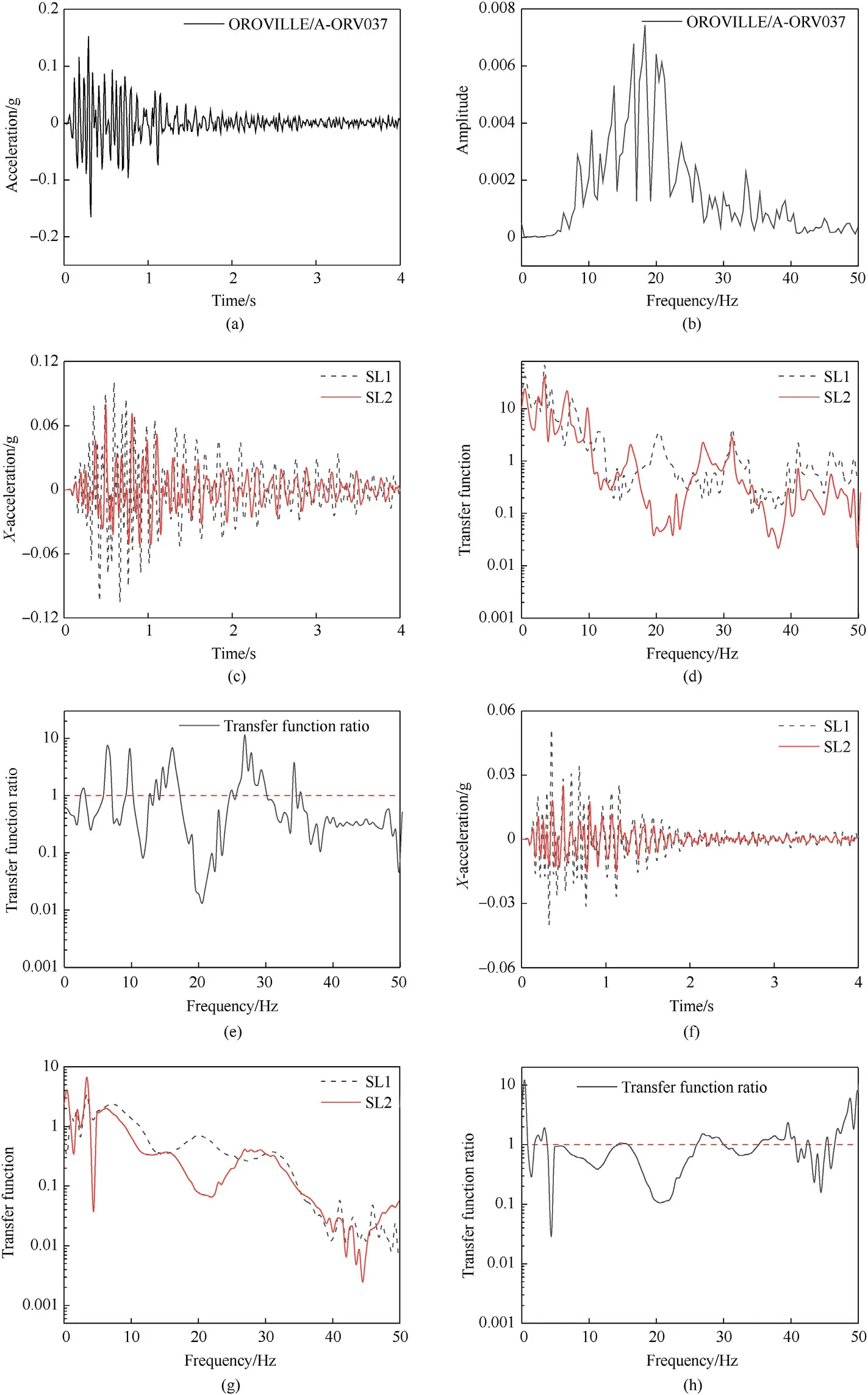
Fig.8.Oroville earthquake wave expressed in (a) the time domain and (b) the frequency domain [24];(c) Horizontal acceleration response; (d) Transfer function and (e) transfer function ratio of SL2 with resonance frequency of 20 Hz and system damping constant of 1.1 rad/s; (f) Horizontal acceleration response; (g) Transfer function and (h) transfer function ratio of SL2 with resonance frequency of 20 Hz and system damping constant of 22 rad/s.
6.Conclusions
In this study, metastructures with concrete-rubber layered structure and embedded rubber-mass resonators were designed and analyzed.The metastructure has excellent wave attenuation effect.
1) The concrete-rubber layered structure has good vibration attenuation ability at relatively high frequency.The FRF curves always have several peak points.Embedded with resonators with specific frequency,the wave attenuation will be fulfilled at the designed frequency and wave attenuation bandgap can be formed.
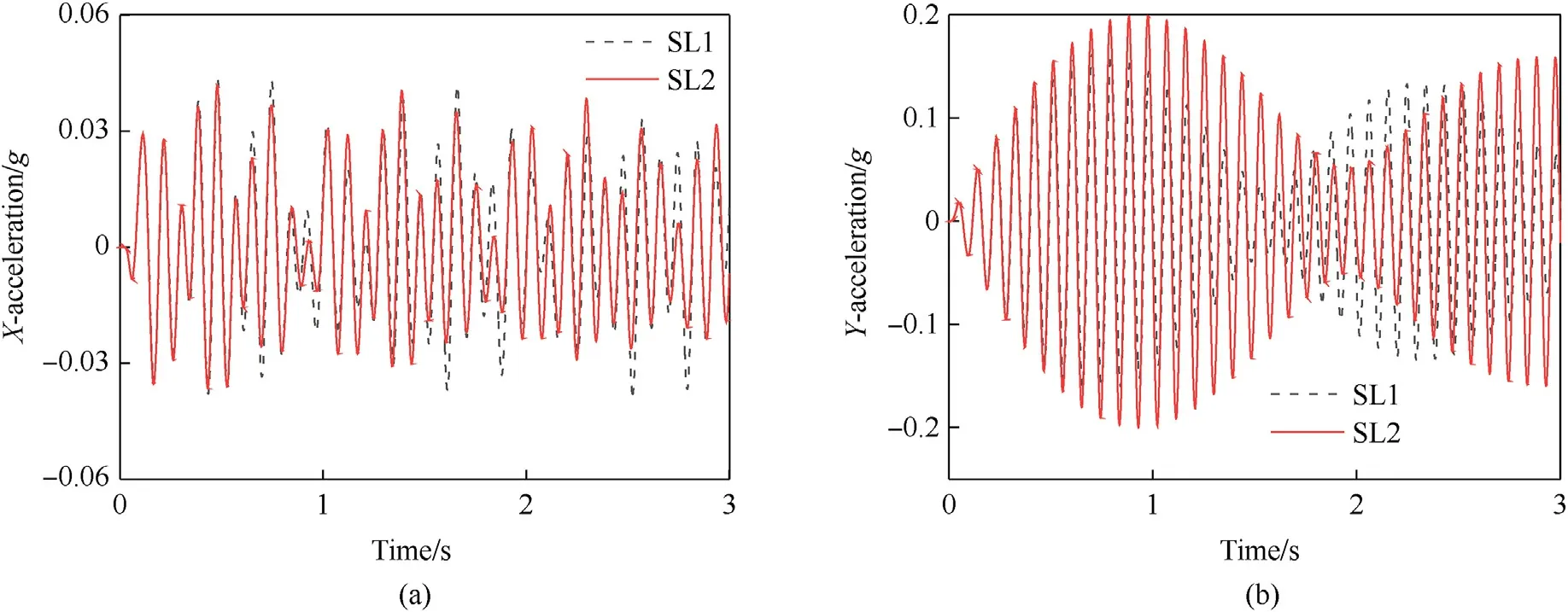
Fig.9.Output acceleration comparisons between two foundations under fixed frequency sweeping at (a) 11 Hz horizontally and (b) 11 Hz vertically.
2) With multi-frequency resonators, the metastructure can form multi-bandgap with excellent vibration attenuation.It is also found that when resonators with different frequencies distribute in different layers the metastructure has better attenuation effect and wider bandgap.
3) The designed metastructure has much better seismic wave attenuation ability than concrete-rubber layered structure when the seismic acceleration time history curve in the 1975 Oroville earthquake is exerted.Resonators designed for the dominant frequency of the seismic wave can greatly attenuate the acceleration response of the structure, and multi-frequency resonators also play an excellent role in the certain frequency of the building itself in vibration reduction and seismic isolation.
Declaration of competing interest
The authors declare that they have no known competing financial interests or personal relationships that could have appeared to influence the work reported in this paper.
Acknowledgements
Supports from National Natural Science Foundation of China(Grant Nos.U20A20286 and 11972184), the Systematic Project of Guangxi Key Laboratory of Disaster Prevention and Engineering Safety (Grant No.2021ZDK006), Natural Science Foundation of Jiangsu Province of China(Grant No.BK20201286)and Science and Technology Project of Jiangsu Province of China (Grant No.BE2020716) are gratefully acknowledged.
- Defence Technology的其它文章
- Ground threat prediction-based path planning of unmanned autonomous helicopter using hybrid enhanced artificial bee colony algorithm
- Predicting impact strength of perforated targets using artificial neural networks trained on FEM-generated datasets
- Construct a 3D microsphere of HMX/B/Al/PTFE to obtain the high energy and combustion reactivity
- Ignition processes and characteristics of charring conductive polymers with a cavity geometry in precombustion chamber for applications in micro/nano satellite hybrid rocket motors
- Recent research in mechanical properties of geopolymer-based ultrahigh-performance concrete: A review
- Effects of projectile parameters on the momentum transfer and projectile melting during hypervelocity impact

